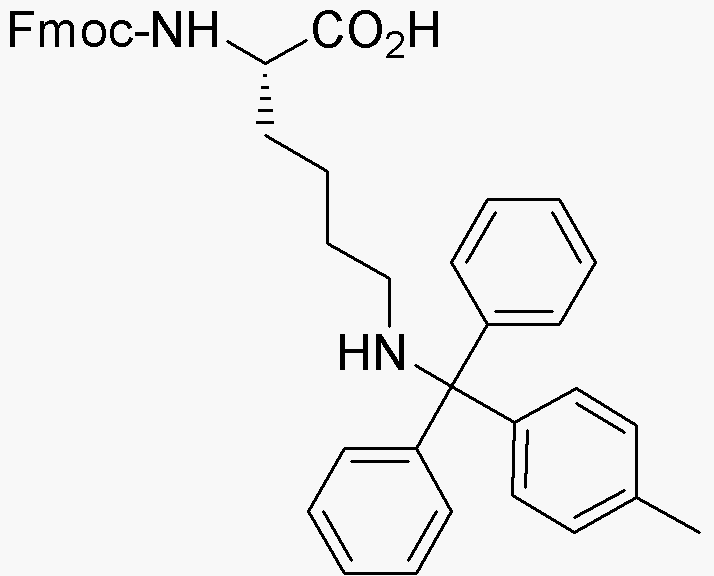Na-Fmoc-Ne-methyltrityl-L-lysine is widely utilized in research focused on:
- Peptide Synthesis: This compound serves as a protecting group for amino acids during peptide synthesis, allowing for the selective modification of specific functional groups without affecting others.
- Drug Development: In pharmaceutical research, it is used to create peptide-based drugs, enhancing the stability and efficacy of therapeutic agents.
- Bioconjugation: The compound facilitates the attachment of peptides to other biomolecules, which is crucial in developing targeted therapies and diagnostics in biotechnology.
- Protein Engineering: Researchers utilize it to modify lysine residues in proteins, improving their properties for various applications in enzyme engineering and synthetic biology.
- Research in Cancer Therapy: Its application in creating peptide conjugates has shown promise in targeted cancer therapies, providing a more effective treatment option with reduced side effects.
General Information
Properties
Safety and Regulations
Applications
Na-Fmoc-Ne-methyltrityl-L-lysine is widely utilized in research focused on:
- Peptide Synthesis: This compound serves as a protecting group for amino acids during peptide synthesis, allowing for the selective modification of specific functional groups without affecting others.
- Drug Development: In pharmaceutical research, it is used to create peptide-based drugs, enhancing the stability and efficacy of therapeutic agents.
- Bioconjugation: The compound facilitates the attachment of peptides to other biomolecules, which is crucial in developing targeted therapies and diagnostics in biotechnology.
- Protein Engineering: Researchers utilize it to modify lysine residues in proteins, improving their properties for various applications in enzyme engineering and synthetic biology.
- Research in Cancer Therapy: Its application in creating peptide conjugates has shown promise in targeted cancer therapies, providing a more effective treatment option with reduced side effects.
Documents
Safety Data Sheets (SDS)
The SDS provides comprehensive safety information on handling, storage, and disposal of the product.
Product Specification (PS)
The PS provides a comprehensive breakdown of the product’s properties, including chemical composition, physical state, purity, and storage requirements. It also details acceptable quality ranges and the product's intended applications.
Certificates of Analysis (COA)
Search for Certificates of Analysis (COA) by entering the products Lot Number. Lot and Batch Numbers can be found on a product’s label following the words ‘Lot’ or ‘Batch’.
Numéro de catalogue
Numéro de lot/série
Certificates Of Origin (COO)
This COO confirms the country where the product was manufactured, and also details the materials and components used in it and whether it is derived from natural, synthetic, or other specific sources. This certificate may be required for customs, trade, and regulatory compliance.
Numéro de catalogue
Numéro de lot/série
Safety Data Sheets (SDS)
The SDS provides comprehensive safety information on handling, storage, and disposal of the product.
DownloadProduct Specification (PS)
The PS provides a comprehensive breakdown of the product’s properties, including chemical composition, physical state, purity, and storage requirements. It also details acceptable quality ranges and the product's intended applications.
DownloadCertificates of Analysis (COA)
Search for Certificates of Analysis (COA) by entering the products Lot Number. Lot and Batch Numbers can be found on a product’s label following the words ‘Lot’ or ‘Batch’.
Numéro de catalogue
Numéro de lot/série
Certificates Of Origin (COO)
This COO confirms the country where the product was manufactured, and also details the materials and components used in it and whether it is derived from natural, synthetic, or other specific sources. This certificate may be required for customs, trade, and regulatory compliance.


